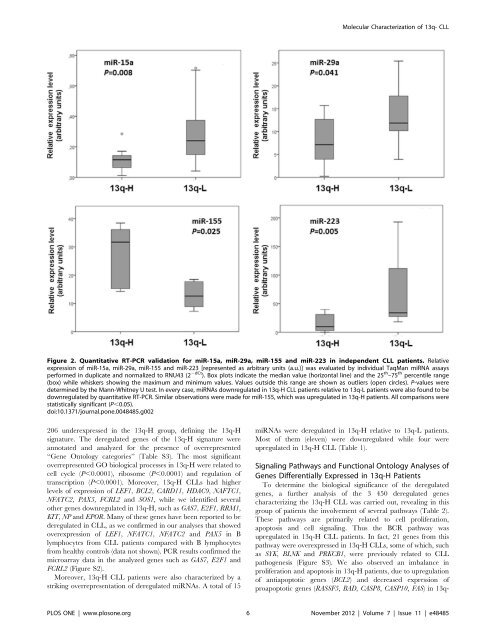Alberto Risueño Pérez - Gredos - Universidad de Salamanca
Alberto Risueño Pérez - Gredos - Universidad de Salamanca
Alberto Risueño Pérez - Gredos - Universidad de Salamanca
You also want an ePaper? Increase the reach of your titles
YUMPU automatically turns print PDFs into web optimized ePapers that Google loves.
206 un<strong>de</strong>rexpressed in the 13q-H group, <strong>de</strong>fining the 13q-H<br />
signature. The <strong>de</strong>regulated genes of the 13q-H signature were<br />
annotated and analyzed for the presence of overrepresented<br />
‘‘Gene Ontology categories’’ (Table S3). The most significant<br />
overrepresented GO biological processes in 13q-H were related to<br />
cell cycle (P,0.0001), ribosome (P,0.0001) and regulation of<br />
transcription (P,0.0001). Moreover, 13q-H CLLs had higher<br />
levels of expression of LEF1, BCL2, CARD11, HDAC9, NAFTC1,<br />
NFATC2, PAX5, FCRL2 and SOS1, while we i<strong>de</strong>ntified several<br />
other genes downregulated in 13q-H, such as GAS7, E2F1, RRM1,<br />
KIT, NP and EPOR. Many of these genes have been reported to be<br />
<strong>de</strong>regulated in CLL, as we confirmed in our analyses that showed<br />
overexpression of LEF1, NFATC1, NFATC2 and PAX5 in B<br />
lymphocytes from CLL patients compared with B lymphocytes<br />
from healthy controls (data not shown). PCR results confirmed the<br />
microarray data in the analyzed genes such as GAS7, E2F1 and<br />
FCRL2 (Figure S2).<br />
Moreover, 13q-H CLL patients were also characterized by a<br />
striking overrepresentation of <strong>de</strong>regulated miRNAs. A total of 15<br />
Molecular Characterization of 13q- CLL<br />
Figure 2. Quantitative RT-PCR validation for miR-15a, miR-29a, miR-155 and miR-223 in in<strong>de</strong>pen<strong>de</strong>nt CLL patients. Relative<br />
expression of miR-15a, miR-29a, miR-155 and miR-223 [represented as arbitrary units (a.u.)] was evaluated by individual TaqMan miRNA assays<br />
performed in duplicate and normalized to RNU43 (2 2dCt ). Box plots indicate the median value (horizontal line) and the 25 th –75 th percentile range<br />
(box) while whiskers showing the maximum and minimum values. Values outsi<strong>de</strong> this range are shown as outliers (open circles). P-values were<br />
<strong>de</strong>termined by the Mann-Whitney U test. In every case, miRNAs downregulated in 13q-H CLL patients relative to 13q-L patients were also found to be<br />
downregulated by quantitative RT-PCR. Similar observations were ma<strong>de</strong> for miR-155, which was upregulated in 13q-H patients. All comparisons were<br />
statistically significant (P,0.05).<br />
doi:10.1371/journal.pone.0048485.g002<br />
miRNAs were <strong>de</strong>regulated in 13q-H relative to 13q-L patients.<br />
Most of them (eleven) were downregulated while four were<br />
upregulated in 13q-H CLL (Table 1).<br />
Signaling Pathways and Functional Ontology Analyses of<br />
Genes Differentially Expressed in 13q-H Patients<br />
To <strong>de</strong>termine the biological significance of the <strong>de</strong>regulated<br />
genes, a further analysis of the 3 450 <strong>de</strong>regulated genes<br />
characterizing the 13q-H CLL was carried out, revealing in this<br />
group of patients the involvement of several pathways (Table 2).<br />
These pathways are primarily related to cell proliferation,<br />
apoptosis and cell signaling. Thus the BCR pathway was<br />
upregulated in 13q-H CLL patients. In fact, 21 genes from this<br />
pathway were overexpressed in 13q-H CLLs, some of which, such<br />
as SYK, BLNK and PRKCB1, were previously related to CLL<br />
pathogenesis (Figure S3). We also observed an imbalance in<br />
proliferation and apoptosis in 13q-H patients, due to upregulation<br />
of antiapoptotic genes (BCL2) and <strong>de</strong>creased expression of<br />
proapoptotic genes (RASSF5, BAD, CASP8, CASP10, FAS) in 13q-<br />
PLOS ONE | www.plosone.org 6 November 2012 | Volume 7 | Issue 11 | e48485
















